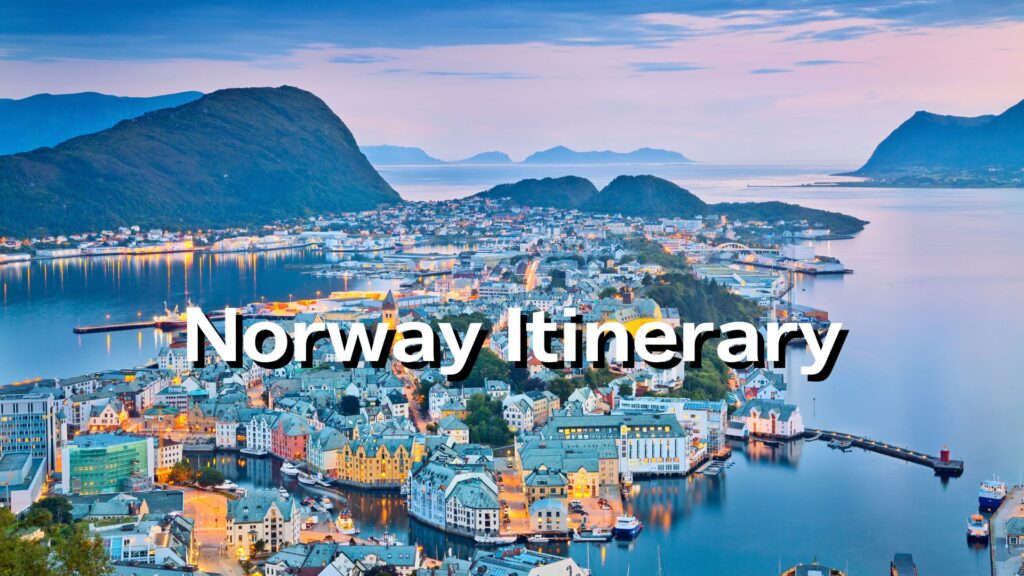Planning a trip to Italy? The best time to visit depends on what you're after—whether it's avoidin...
Travel Guides
Norway offers a breathtaking blend of nature and culture. This itinerary highlights the must-visit spots for an unforgettable trip.


By 2028, international tourist arrivals in Norway are expected to surpass 6.5 million, reflecting steady growth in the country’s tourism sector, according to ReportLinker. This Norway itinerary will help you determine which top destinations and must-see landmarks you should visit first.
If you only have one day in Norway, Oslo is the best place to start, offering a perfect mix of history, nature, and culture within a compact itinerary.
The Viking Ship Museum houses some of the best-preserved Viking ships and artifacts from Norway’s rich seafaring history. Visitors can see ornate burial ships, tools, and household items that provide insight into Viking life, exploration, and craftsmanship.
Akershus Fortress is a medieval stronghold that once served as Oslo’s primary defense and later became a royal residence and military base. Today, visitors can walk through its historic grounds, explore the fortress walls, and enjoy panoramic views of Oslofjord.
Take a stroll through Vigeland Park, the world's largest sculpture park by a single artist, featuring over 200 bronze, granite, and iron statues by Gustav Vigeland. Visit the Vigeland Museum, located nearby, to explore the artist’s early works, plaster models, and personal history. Then, head to Aker Brygge, a lively waterfront area with restaurants serving fresh Norwegian seafood.
Visit The Royal Palace, the official residence of Norway’s monarch, to admire its grand architecture and learn about its historic significance. Built in the 19th century, the palace serves as the King’s residence and a venue for official state events. Visitors can admire the elegant exterior, stroll through the surrounding palace park, and watch the changing of the guard ceremony.
Karl Johans Gate is Oslo’s main street, stretching from the Royal Palace to Oslo Central Station. Lined with shops, cafés, restaurants, and historic landmarks, it’s a lively area perfect for strolling, shopping, and people-watching.
The Munch Museum in Oslo is home to the world’s largest collection of works by Edvard Munch, including his iconic masterpiece, The Scream. The museum offers an immersive experience with paintings, sketches, photographs, and personal artifacts, showcasing Munch’s artistic evolution and deep influence on modern art.
The Oslo Opera House is a striking architectural landmark, designed to resemble an iceberg rising from the Oslofjord. Visitors can walk on its sloping marble roof for panoramic views of the city and waterfront, while inside, world-class performances of opera and ballet take place in its stunning auditorium.
Afterward, dine at Fiskeriet, a well-known seafood bistro serving traditional Norwegian dishes like fish soup and grilled salmon. Expect to pay NOK 250 – 500 ($23 – $47) per person.
If you have 2–3 days in Norway, this itinerary builds on day 1 to take you beyond Oslo and into Norway’s stunning fjords and historic coastal cities. Explore Bergen’s UNESCO-listed wharf, ride a scenic funicular to Mount Fløyen, and learn about Norway’s seafaring heritage. With stops at charming villages, cascading waterfalls, and breathtaking fjords, this journey offers a perfect mix of nature, culture, and adventure.
Bergen, known as the "Gateway to the Fjords," is a charming city filled with colorful wooden houses and stunning waterfront views.
Explore Bryggen Wharf, a UNESCO World Heritage Site known for its historic wooden buildings and vibrant culture. Once a key trading hub for the Hanseatic League, this picturesque waterfront district now hosts museums, artisan shops, and charming cafés, offering a glimpse into Bergen’s rich maritime past.
Discover Bergen’s Hanseatic history at the Hanseatic Museum and Schøtstuene, part of Museum Vest. Step inside the preserved merchant houses to see how Hanseatic traders lived and worked, surrounded by original artifacts and period furnishings. Explore Schøtstuene, the reconstructed assembly rooms where merchants gathered, offering a deeper look into Bergen’s role as a medieval trading hub.
Ride the Fløibanen Funicular, a scenic railway that takes you up Mount Fløyen in just 6 minutes, offering stunning views along the way. At the top, enjoy breathtaking panoramic views of Bergen and the surrounding fjords, with opportunities for hiking, wildlife spotting, and café stops.
This full-day self-guided tour takes you from Bergen to Hardangerfjord and Eidfjord, showcasing Norway’s stunning fjord landscapes. Begin with a scenic bus ride to Norheimsund, where you’ll board a fjord cruise past fruit orchards, waterfalls, and picturesque villages.
Upon arrival in Eidfjord, enjoy 3 hours and 40 minutes of free time to explore the village, visit local shops, or admire the surrounding nature. On the return journey, stop at Steinsdalsfossen waterfall, where you can walk behind the cascading water before heading back to Bergen.
With 4 to 7 days in Norway, you can explore its famous fjords, Arctic wonders, and coastal villages. This itinerary includes a cruise through Nærøyfjord, a visit to Tromsø for the northern lights, and a trip to the Lofoten Islands for outdoor activities and stunning scenery.
The Nærøyfjord Cruise offers a breathtaking journey through one of Norway’s most narrow and dramatic fjords, surrounded by steep mountains, cascading waterfalls, and charming villages.
Along the way, you’ll pass tiny farms clinging to the mountainsides, deep valleys, and untouched natural landscapes, making it a must-do experience for nature lovers and photographers alike.
Tromsø, located at 69°N in Northern Norway, seamlessly blends urban life with pristine Arctic nature, offering experiences like the northern lights in winter and the midnight sun in summer.
A Tromsø Pass grants visitors access to top attractions, including the Polar Museum, the Arctic University Museum of Norway, Polaria, the Science Centre of Northern Norway, and the Arctic Cathedral, making it a convenient way to explore the city's cultural and natural highlights.
The Lofoten Islands, located above the Arctic Circle in Northern Norway, are famous for their dramatic peaks, pristine beaches, and picturesque fishing villages.
Travelers can reach Lofoten by flying into Leknes or Svolvær Airport, taking a ferry from Bodø, or driving along the scenic E10 highway. Outdoor enthusiasts can hike rugged mountain trails, kayak through fjords, chase the northern lights in winter, or experience the midnight sun in summer.
Whether exploring the iconic Reine village, surfing at Unstad Beach, or fishing in the Arctic waters, Lofoten offers a unique blend of adventure and breathtaking scenery.
Budget estimates:
Norway has a variety of accommodations, from luxury hotels with fjord views to budget-friendly stays in city centers. This list includes top-rated options in Oslo, Bergen, and Tromsø, catering to different budgets and travel styles.
Price: NOK 4,033 ($380)
Located in Oslo’s trendy Tjuvholmen district, The Thief is a five-star waterfront hotel known for its modern design, private balconies, and stunning fjord views. With a world-class spa, rooftop bar, and easy access to the Astrup Fearnley Museum, it’s a top choice for luxury travelers seeking style and exclusivity.
Address: Vågsallmenningen 16, 5014 Bergen
Price: NOK 2,760 ($260)
Set in a historic building inspired by composer Edvard Grieg, Opus XVI blends elegance with modern comfort in the heart of Bergen. Just minutes from Bryggen Wharf and the Fish Market, it offers sophisticated rooms, an upscale restaurant, and a rich cultural ambiance.
Address: Grønnegata 35, 9008 Tromsø, Norway
Price: NOK 1,800 ($170)
Ideal for budget-conscious travelers, Comfort Hotel Xpress Tromsø offers modern, no-frills accommodation in the city center. A short walk from Tromsø’s nightlife, restaurants, and Northern Lights tours, it provides affordable comfort without compromising on location.
For seamless mobile internet access, using an eSIM is a convenient option while traveling in Norway. Learn more about how to get mobile internet in Norway, and explore a comparison of different eSIM providers below:
| Provider | Pros | Cons | Price | |
| Holafly | Unlimited data, easy installation | Limited data sharing, no calls or SMS support | $6.90 unlimited data per day | |
| Flexiroam | Works in multiple countries, multiple top-up options | May have slower speeds in rural areas, has a higher price per GB | $8 1GB data for 7 days | |
| Airalo | Affordable pricing, supports data top-up | Limited coverage in rural areas, no phone calls or SMS support | $4.50 1GB data for 7 days | |
The best time to visit Norway depends on your plans. Summer (June–August) offers long daylight hours and mild temperatures, ideal for fjords, hiking, and coastal towns. Winter (November–March) is best for northern lights, Arctic activities, and skiing.
Norway has an efficient train and bus network, but renting a car is recommended for flexibility, especially in rural areas. Domestic flights are available for long distances, and ferries are essential for exploring the fjords and coastal regions.
Norway is known for its high cost of living, but budget travelers can save by using public transport, staying in budget accommodations, and self-catering meals. City passes, like the Tromsø Pass or Oslo Pass, provide discounts on attractions and transport.

